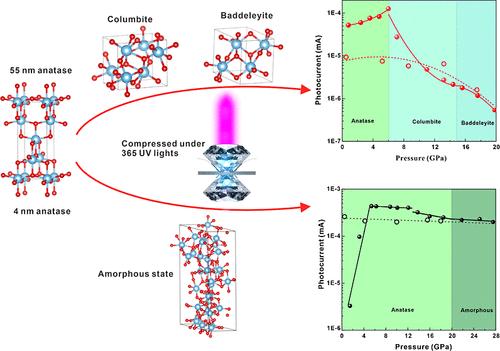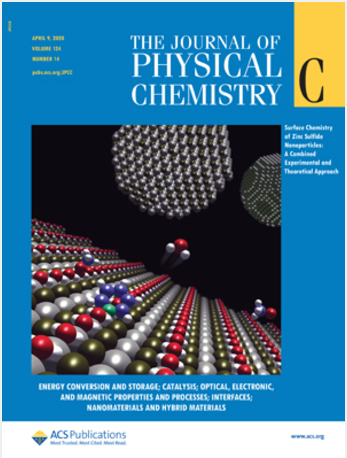Pressure Effects on the Optoelectronic Property of Nanocrystalline Anatase with Different Sizes
IF 3.3
3区 化学
Q2 CHEMISTRY, PHYSICAL
引用次数: 0
Abstract
In this study, we investigated the photoelectric properties of nanosized anatase (∼55 and ∼4 nm) under high pressure, utilizing in situ Raman spectroscopy, photocurrent measurements, and theoretical calculations up to 27.6(5) GPa. Our findings reveal that 55 nm anatase shows a significant photocurrent increase of 2.4 times compared to ambient conditions before transitioning to the columbite phase at around 5.5(1) GPa. After this transition, the photocurrent gradually decreased up to 19.8(4) GPa. Notably, the columbite phase exhibited superior optoelectronic performance compared to the baddeleyite phase observed at approximately 15.5(3) GPa. For ∼4 nm anatase, an exceptional photocurrent increase of approximately 131 times was observed at 5.4(1) GPa compared to 1.5(0) GPa, with only a slight decrease between 5.4(1) and 27.6(5) GPa, and maintained a high level even after pressure release. The observed variations in photocurrent are attributed to changes in resistance, band gap, and absorption coefficient, each influencing the material’s response differently across various pressure ranges. These results underscore the potential of pressure-induced modulation to dramatically enhance the photoelectric properties of nanosized anatase, especially in ∼4 nm anatase. The ability to control the crystal structure and UV light response through pressure offers a promising strategy for improving the performance of TiO2-based ultraviolet photodetectors, making them more effective for advanced photoelectric applications.

压力对不同尺寸纳米晶钛白粉光电特性的影响
在这项研究中,我们利用原位拉曼光谱、光电流测量和高达 27.6(5) GPa 的理论计算,研究了纳米级锐钛矿(55 纳米和 4 纳米)在高压下的光电特性。我们的研究结果表明,55 纳米锐钛矿在 5.5(1) GPa 左右过渡到铌铁矿相之前,光电流比环境条件下显著增加了 2.4 倍。过渡后,光电流逐渐下降,直至 19.8(4) GPa。值得注意的是,与在约 15.5(3) GPa 时观察到的巴德来特相相比,铌铁矿相表现出更优越的光电性能。就 4 纳米锐钛矿而言,与 1.5(0) GPa 相比,5.4(1) GPa 时的光电流增加了约 131 倍,5.4(1) 至 27.6(5) GPa 之间的光电流仅略有下降,甚至在压力释放后仍保持在较高水平。观察到的光电流变化可归因于电阻、带隙和吸收系数的变化,它们在不同的压力范围内对材料的响应产生不同的影响。这些结果凸显了压力诱导调制显著增强纳米锐钛矿(尤其是 4 纳米锐钛矿)光电特性的潜力。通过压力控制晶体结构和紫外光响应的能力为提高基于二氧化钛的紫外光检测器的性能提供了一种有前途的策略,使它们在先进的光电应用中更加有效。
本文章由计算机程序翻译,如有差异,请以英文原文为准。
求助全文
约1分钟内获得全文
求助全文
来源期刊

The Journal of Physical Chemistry C
化学-材料科学:综合
CiteScore
6.50
自引率
8.10%
发文量
2047
审稿时长
1.8 months
期刊介绍:
The Journal of Physical Chemistry A/B/C is devoted to reporting new and original experimental and theoretical basic research of interest to physical chemists, biophysical chemists, and chemical physicists.
 求助内容:
求助内容: 应助结果提醒方式:
应助结果提醒方式:


